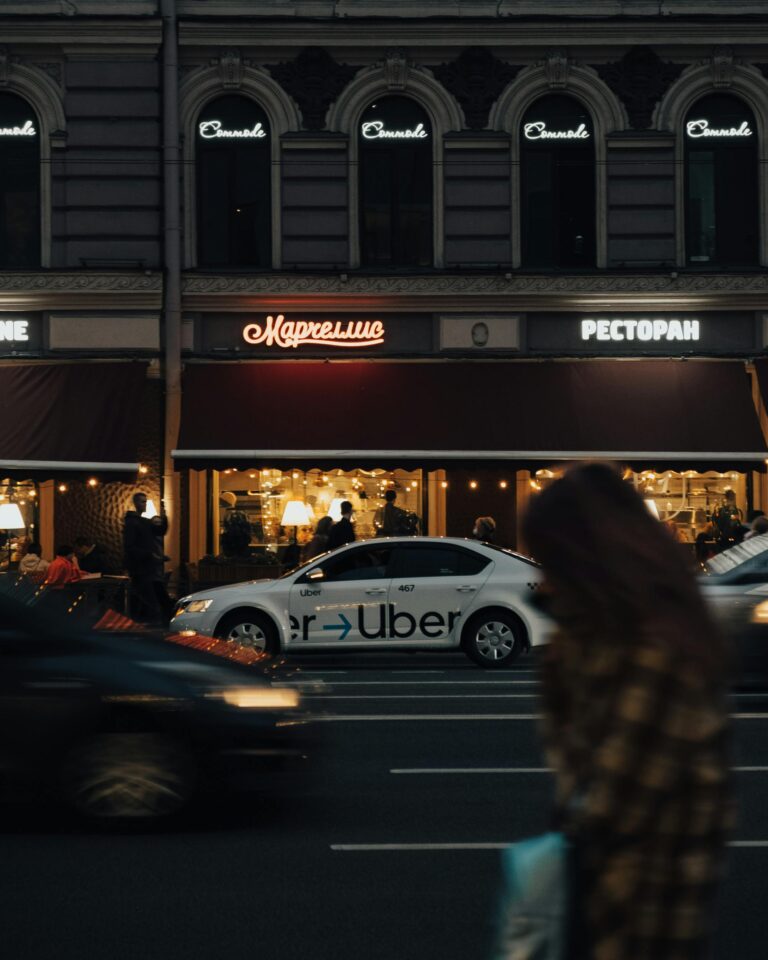Being your own boss as a self-employed courier offers incredible freedom and flexibility, but it also comes with significant responsibilities especially when it comes to insurance protection!
In the UK as a self-employed courier you need; Hire & Reward Vehicle Insurance, Goods in Transit cover and Public Liability as a minimum. You should also consider insurances for personal accident and income protection cover
According to recent industry data, nearly 68% of independent couriers are underinsured, putting their livelihoods and personal assets at serious risk. Whether you’re delivering packages, food, or documents, having the right insurance coverage isn’t just a legal requirement, it’s crucial financial protection against the unexpected.
The right insurance cover can literally be the difference between business continuity and financial disaster when accidents happen. This guide will walk you through exactly what insurance you need to protect yourself, your vehicle, and your courier business.
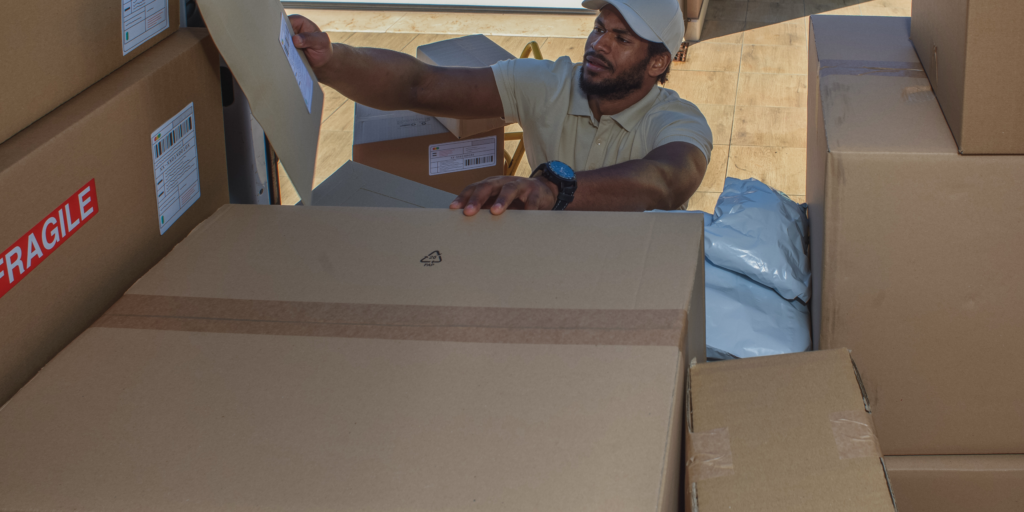
Understanding the Risks of Self-Employed Courier Work
Working as a self-employed courier in the UK offers tremendous flexibility and income potential, but it also exposes you to unique risks that many new delivery professionals overlook.
Recent research from the Association of British Insurers (ABI) has revealed that an alarming 71% of independent UK couriers operate without adequate insurance protection, often due to confusion about what coverage is actually needed. This knowledge gap creates significant financial vulnerability that can devastate your business and personal finances when accidents inevitably occur.
The UK delivery landscape has transformed dramatically since 2020, with the number of self-employed couriers increasing by over 250% according to Office for National Statistics data, particularly across food delivery, e-commerce package delivery, and specialised transportation services. This explosive growth has unfortunately coincided with a 53% increase in courier related accident claims, according to data from the Motor Insurers’ Bureau. The most common incidents involve vehicle collisions, damage to transported goods, personal injuries, and third-party property damage.
Financial Implications of Inadequate Coverage
The financial consequences of operating without proper insurance in the UK can be catastrophic. Consider these sobering statistics:
| Type of Incident | Average Cost Without Insurance | Frequency Among UK Couriers |
|---|---|---|
| Vehicle collision | £12,500 | 1 in 5 couriers annually |
| Damaged/lost package | £650 per incident | 1 in 14 deliveries |
| Customer property damage | £4,200 | 1 in 35 couriers annually |
| Personal injury | £7,800 + lost income | 1 in 12 couriers annually |
| Legal defense costs | £5,000 – £20,000 | Varies by claim type |
These figures highlight why proper insurance isn’t just a regulatory requirement, it’s essential financial protection.
Martin S., a food delivery courier in Manchester, learned this lesson the hard way when a minor collision resulted in £9,800 of damage to his vehicle and the other driver’s car. Without proper Hire and Reward insurance, he was personally responsible for all costs after his personal insurance denied the claim because he was working at the time of the accident.
UK Legal Requirements for Courier Insurance
Unlike many countries with confusing regional variations, the UK has established clear insurance standards for all delivery professionals through regulations enforced by the Department for Transport and industry standards like the “Courier Code of Practice“:
| Insurance Type | UK Requirement | Minimum Coverage |
|---|---|---|
| Hire and Reward | Legally mandatory | Class 3 Business Use minimum |
| Goods in Transit | Required by most contracts | £5,000-£10,000 minimum |
| Public Liability | Industry standard | £1-2 million minimum |
| Personal Accident | Recommended | Variable based on income |
| Employers’ Liability | Required if you hire others | £5 million by law |
💡 Pro Tip: It’s important to note that standard UK Social Domestic & Pleasure (SDP) car insurance explicitly excludes delivery work. Operating without proper Hire and Reward insurance is not only financially risky but also illegal under UK law, potentially resulting in penalty points, fines up to £5,000, and even vehicle seizure.
Major UK delivery platforms like Deliveroo, Just Eat, and Amazon Flex have their own insurance requirements that align with these regulations. However, it’s crucial to understand that platform provided insurance typically offers limited protection with significant gaps in cover that leave couriers personally exposed. For example, most platform insurance only covers you while actively delivering, leaving you unprotected during “waiting time” between deliveries.
Real Life Protection Scenarios from UK Couriers
The value of proper insurance coverage becomes most evident through real life examples from the UK courier industry:
James H., a package courier in Leeds, experienced a break-in where several high-value parcels were stolen from his vehicle during a brief stop. His goods-in-transit insurance covered the £5,600 in merchandise, protecting him from personal liability and preserving his contract with the delivery service.
Emma T., a bicycle courier delivering food in London, accidentally damaged an expensive shop front display. The £2,800 repair cost was fully covered by her public liability insurance, preventing what could have been a devastating personal expense.
Raj P., who delivers medical supplies across Birmingham, slipped on wet pavement during a delivery and fractured his wrist. Unable to work for 8 weeks, his personal accident insurance provided £6,400 in income replacement, covering his rent and bills during recovery.
Different Delivery Types, Different Insurance Needs
The type of deliveries you perform in the UK significantly impacts your insurance requirements. Food delivery generally requires less goods-in-transit cover but may need additional liability protection for food safety incidents. Package couriers typically need higher goods-in-transit limits, especially when handling valuable merchandise. Medical couriers require specialised coverage for transporting regulated substances, temperature sensitive items, and confidential patient materials under NHS guidelines.
Understanding these nuances is essential for building appropriate insurance protection. Many UK couriers make the mistake of purchasing generic business insurance rather than coverage tailored to delivery specific risks, leaving dangerous gaps in their protection.
The UK courier industry continues to evolve rapidly, with new platforms, services, and customer expectations emerging regularly, further shaped by post Brexit regulatory changes. This evolution brings additional risks that many traditional insurance policies haven’t yet addressed. Working with insurance providers who specialise in the UK gig economy and courier services ensures your coverage evolves alongside these changing risks, providing comprehensive protection for your delivery business.

Hire and Reward Insurance: The Foundation of Courier Protection in the UK
For self-employed couriers in the UK, having the right vehicle insurance isn’t just a legal requirement, it’s the fundamental cornerstone of your business protection. Standard personal car insurance (known as Social, Domestic and Pleasure or SDP cover) explicitly excludes any delivery work, creating a serious risk for couriers who haven’t upgraded their policy.
According to recent data from the Motor Insurers’ Bureau, approximately 43% of UK delivery drivers are operating with inappropriate insurance coverage, placing themselves at risk of serious financial and legal consequences.
Why Standard Car Insurance Doesn’t Protect Couriers
Many new couriers make the critical mistake of assuming their existing personal car insurance will cover them while making deliveries. This misconception can have devastating consequences. Standard vehicle policies in the UK are designed for personal use, not commercial activities. When insurance companies discover you’ve been using your vehicle for courier work on a personal policy, they will typically:
- Immediately invalidate your entire policy
- Refuse to pay any claims related to incidents that occurred while working
- Potentially report you to the Motor Insurance Database as having no valid insurance
- In some cases, pursue recovery of previous claim payments if they determine you were working at the time
The consequences extend beyond just denied claims. Driving without appropriate insurance in the UK is a criminal offence that can result in:
- A fixed penalty of £300
- Six penalty points on your licence
- Potential vehicle seizure by police
- Possible disqualification from driving if you accrue 12 or more points
- Significantly higher insurance premiums in the future
- “IN10” endorsement on your licence (driving without insurance)
Understanding Hire and Reward Insurance
In the UK, couriers need specific “Hire and Reward” insurance, which covers you for transporting other people’s goods in exchange for payment. This is different from standard business use insurance, which typically covers commuting or visiting multiple work locations but not delivery work.
Hire and Reward insurance comes in several forms:
| Type of Cover | What It Provides | Typical Cost Range |
|---|---|---|
| Third-Party Only | Minimal legal coverage for damage to others | £1,200-£2,000 annually |
| Third-Party, Fire & Theft | Adds protection for your vehicle against fire/theft | £1,500-£2,500 annually |
| Comprehensive | Full coverage including damage to your own vehicle | £2,000-£3,500 annually |
For most self-employed couriers, comprehensive cover represents the best value despite its higher premium, as it protects your most valuable business asset, your vehicle. Without it, even minor accidents could leave you unable to work and facing significant repair costs.
Factors Affecting Your Hire and Reward Insurance Premiums
UK insurance providers consider several key factors when calculating premiums for courier insurance:
1. Vehicle Type and Value
Vehicles commonly used for courier work in the UK vary widely in their insurance costs. Smaller, more economical vehicles typically attract lower premiums. Based on data from leading UK courier insurers, here’s how different vehicles compare:
| Vehicle Type | Average Annual Premium | Notes |
|---|---|---|
| Small hatchback (e.g., Ford Fiesta) | £1,800-£2,400 | Most economical option |
| Medium van (e.g., Ford Transit Custom) | £2,300-£3,200 | Higher costs but more capacity |
| Large van (e.g., Mercedes Sprinter) | £2,800-£3,800 | Highest premiums but maximum capacity |
| Motorcycle/Scooter | £1,200-£2,000 | Economical but weather-dependent |
2. Delivery Type and Radius
The type of items you deliver and your operating radius significantly impact your insurance costs:
- Local food delivery (under 10-mile radius): Typically attracts lower premiums
- Multi-drop parcel delivery: Medium premium range
- Long-distance courier work: Highest premium bracket
- Specialist deliveries (medical, high-value): Additional premium loading
3. Driver History and Experience
For UK couriers, your driving history is perhaps the most significant factor affecting premiums:
- Clean licence with no claims: Potential discounts of 10-30%
- Previous claims or convictions: Premium increases of 25-100%
- Less than 2 years’ driving experience: 40-60% higher premiums
- Age under 25: Typically 30-50% higher premiums
4. Annual Mileage
The distance you drive annually directly correlates with risk exposure:
- Under 10,000 annual miles: Standard rates
- 10,000-20,000 miles: 15-25% premium increase
- Over 20,000 miles: 25-40% premium increase
Making Your Hire and Reward Insurance More Affordable
Despite the higher premiums associated with courier insurance, there are several strategies UK couriers can use to reduce costs:
1. Pay Annually Rather Than Monthly
Annual payment typically saves 10-15% compared to monthly instalments.
2. Install Vehicle Security and Tracking Devices
Approved security devices and GPS trackers can reduce premiums by 5-10%.
3. Increase Voluntary Excess
Accepting a higher excess can reduce premiums, but ensure it remains affordable should you need to claim.
4. Consider Limited Hours Policies
If you only courier part-time, some insurers offer limited-hours policies at reduced rates.
5. Complete Advanced Driving Qualifications
Courses like the IAM RoadSmart commercial driver assessment can earn discounts with some insurers.
6. Join Professional Associations
Membership in organisations like the Courier Exchange or National Courier and Despatch Association can provide access to group insurance schemes with preferential rates.
What to Look for in Your Policy Documents
When purchasing Hire and Reward insurance in the UK, pay careful attention to these key aspects of your policy:
1. Class of Use Specification
Ensure your policy explicitly states “Hire and Reward” or “Courier Use” rather than just “Business Use.”
2. Goods Covered
Check what types of goods are covered and excluded. Some policies exclude certain categories like food, electronics, or high-value items.
3. Working Hours Limitations
Some policies restrict coverage to specific hours. Ensure your working pattern is fully covered.
4. Platform-Specific Requirements
If you work for specific delivery platforms like Deliveroo or Amazon Flex, ensure your policy meets their specific requirements.
5. Excess Amounts
Be clear about both compulsory and voluntary excess amounts that would apply in the event of a claim.
6. Geographical Limitations
Check if your policy covers your entire operating area, particularly if you work across different regions.
Case Study: The Cost of Inadequate Coverage
A particularly illustrative example comes from Leeds, where courier James M. discovered the consequences of inadequate insurance coverage. Using only standard business class insurance rather than proper Hire and Reward coverage, James was involved in a minor collision while delivering parcels. His insurer not only rejected his £4,200 claim but also cancelled his policy immediately, leaving him uninsured. The other driver’s insurer subsequently pursued him personally for £8,900 in damages. Additionally, he received six penalty points and a £300 fine for effectively driving without valid insurance.
This real-world example demonstrates why proper Hire and Reward insurance isn’t just a regulatory box to tick, it’s essential protection for your courier business, your personal finances, and your ability to continue working legally in the UK delivery industry.
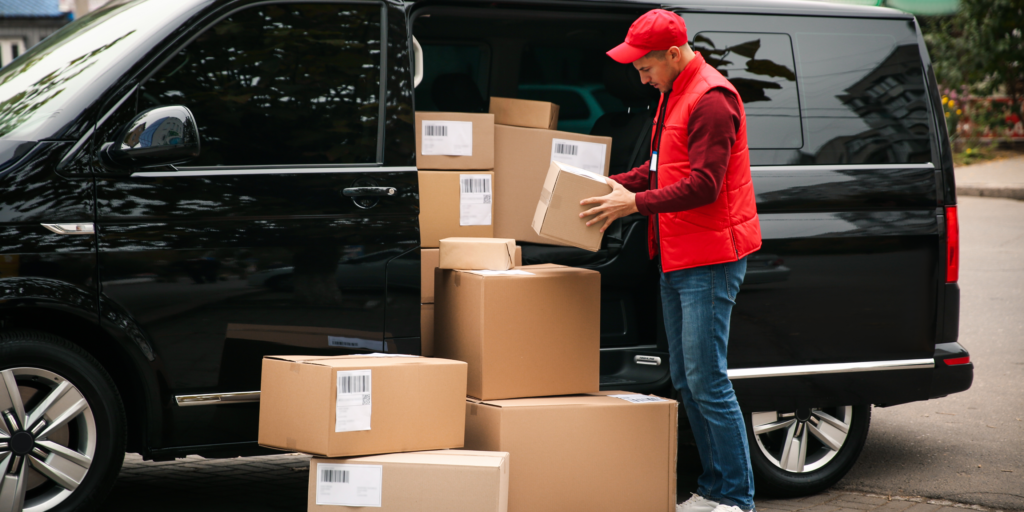
Goods in Transit Insurance: Protecting What You Deliver
While Hire and Reward insurance covers your vehicle and liability on the road, it typically doesn’t protect the parcels, packages, or products you’re transporting. This is where Goods in Transit (GIT) insurance becomes essential for UK couriers. According to the Road Haulage Association, approximately £140 million worth of goods are damaged, lost or stolen during transit in the UK each year, highlighting the significant risk that couriers face without this critical coverage.
What Is Goods in Transit Insurance?
Goods in Transit insurance protects the items you’re carrying on behalf of others against damage, loss or theft while they’re in your possession.
It’s designed specifically to cover the goods themselves rather than your vehicle or third-party liabilities. In the UK delivery ecosystem, this insurance represents a crucial layer of protection for self-employed couriers, with most professional couriers considering it as essential as their vehicle insurance.
The British Insurance Brokers’ Association reports that claims for damaged or lost goods have increased by 37% in the past three years, driven largely by the surge in e-commerce deliveries and the increasing value of items being shipped through courier networks.
Why Goods in Transit Coverage Is Essential for UK Couriers
Many new self-employed couriers make the dangerous assumption that they’re not personally liable for the goods they transport. This misconception stems from a fundamental misunderstanding of UK courier contracts and legal liability. Under UK law and most standard courier agreements:
- You assume “bailee responsibility” for goods in your possession
- You can be held personally liable for their full value if damaged or lost
- This liability exists regardless of whether you personally caused the damage
- Client contracts often include indemnity clauses making you explicitly responsible
Without Goods in Transit insurance, you’re effectively gambling your business and personal finances each time you accept a delivery. Consider these real scenarios from UK couriers:
Case Example: Manchester Courier
A Manchester-based courier had £3,600 worth of electronic equipment stolen from his vehicle while delivering another package. Without GIT insurance, he was personally liable for the full replacement cost, as his client’s terms and conditions specifically transferred this responsibility to him upon collection.
Case Example: Glasgow Delivery Driver
A Glasgow delivery driver was transporting fragile items when he had to brake suddenly, damaging £1,200 worth of goods. Although the incident wasn’t deemed negligent, he remained legally responsible for the items in his care. His Goods in Transit insurance covered the claim in full.
Determining the Right Coverage Limits
Selecting appropriate coverage limits is one of the most critical decisions when purchasing Goods in Transit insurance. UK insurers typically offer policies with limits ranging from £1,000 to £50,000 per vehicle, with the “per vehicle” distinction being particularly important for multi-vehicle operations.
To determine your appropriate coverage limit, consider:
1. Maximum Value Per Load
Calculate the highest possible combined value of goods you might transport at any one time. For multi-drop couriers, this means the total value of all packages on board simultaneously.
2. Average Consignment Value
Review your typical delivery values over the past several months. Most UK couriers find their average consignment value falls between £500-£2,000.
3. Client Requirements
Many UK clients and platforms specify minimum GIT coverage requirements in their contracts:
| Client/Platform Type | Typical Minimum GIT Requirement |
|---|---|
| Amazon Flex | £5,000 per vehicle |
| Corporate courier contracts | £10,000 per vehicle |
| High-value specialist deliveries | £25,000+ per vehicle |
| Standard parcel networks | £2,500-£5,000 per vehicle |
| Food delivery platforms | Often not required |
4. Per-Item Limits
Be aware that many policies impose per-item limits (typically £1,000-£2,500) regardless of your overall coverage limit. If you regularly transport higher-value individual items, ensure your policy accommodates this.
Cost Factors for UK Goods in Transit Insurance
The annual cost of Goods in Transit insurance in the UK varies significantly based on several factors:
| Coverage Level | Typical Annual Cost | Per Month Equivalent |
|---|---|---|
| £5,000 | £120-£300 | £10-£25 |
| £10,000 | £200-£450 | £17-£38 |
| £25,000 | £400-£700 | £33-£58 |
| £50,000 | £650-£1,200 | £54-£100 |
Beyond cover limits, UK insurers consider these key factors when calculating premiums:
1. Delivery Type
The nature of goods you deliver significantly impacts premiums:
- Standard parcels: Baseline rates
- Electronic items: 15-30% premium increase
- Fragile goods: 20-35% premium increase
- Perishable items: 10-25% premium increase
- High-value goods: 30-60% premium increase
2. Security Measures
Vehicle security features can reduce premiums by 5-20%:
- Approved alarm systems
- Immobilisers
- Secure load areas
- CCTV or dashcams
- GPS tracking systems
3. Operating Area
Your primary delivery area affects risk assessment:
- Rural areas: Often lowest premiums
- Suburban areas: Moderate premiums
- City centres: Higher premiums
- Known high-crime postcodes: Highest premiums (20-40% above baseline)
4. Claims History
Previous claims significantly impact future premiums:
- No claims: Potential discounts of 10-30%
- 1-2 minor claims: Minimal impact if spread over years
- Multiple claims: Premium increases of 30-100%
- Recent large claims: Potential difficulty finding coverage
Important Exclusions in Goods in Transit Policies
UK Goods in Transit policies typically contain several important exclusions that couriers must understand:
1. Inadequate Packaging
Claims are commonly rejected when damage results from improper packaging. This can be problematic for couriers who have no control over how clients package items before collection.
2. Overnight Storage
Many policies exclude coverage for goods left in vehicles overnight, typically defined as between 9pm-6am. For couriers who store items in their vehicles, specific overnight coverage is essential.
3. High-Risk Items
Standard policies often exclude or limit coverage for:
- Cash, securities and currency
- Jewellery and precious metals
- Fine art and antiques
- Dangerous goods (flammable, corrosive, etc.)
- Cigarettes and alcohol
- Personal electronic devices
- Designer fashion items
4. Mysterious Disappearance
Items that disappear without evidence of theft (i.e., no forced entry) are often excluded, which can be problematic for multi-drop couriers making frequent stops.
5. Territorial Limitations
Most standard UK policies cover deliveries only within the UK and may exclude certain regions. If you deliver to Northern Ireland, the Channel Islands, or internationally, specific coverage extensions are required.
Making Successful Claims on Your Goods in Transit Policy
The claims process for Goods in Transit insurance in the UK typically involves these key steps:
1. Immediate Documentation
Immediately record any damage or loss:
- Photographs of damaged items/packaging
- Signed confirmation from recipients noting damage
- Police reference numbers for theft (essential for claims)
- GPS location data if available
2. Prompt Notification
Most UK insurers require notification within 24-48 hours of discovering loss or damage.
3. Evidence Collection
Gather supporting documentation:
- Proof of collection (collection notes)
- Delivery instructions
- Item valuation evidence
- Damage assessment reports
4. Claim Submission
Complete the insurer’s claim form with all supporting evidence. Most UK insurers now offer online claim submission portals.
5. Follow-Up
UK insurers typically aim to process GIT claims within 10-21 working days, though complex claims may take longer.
Tips for UK Couriers to Reduce Goods in Transit Risks
Beyond insurance, implementing these practical risk reduction strategies can both decrease your premium costs and reduce the likelihood of claims:
1. Vehicle Security Upgrades
Installing approved security devices can reduce both the risk of theft and your insurance premiums.
2. Handling Protocols
Develop consistent procedures for securing goods during transport, including:
- Using load restraints and dividers
- Implementing temperature control for sensitive items
- Proper stacking techniques to prevent crushing
- Special handling for fragile items
3. Documentation Systems
Maintain thorough records of all collections and deliveries:
- Photographs of items at collection
- Signed proof of delivery
- Condition notes at both collection and delivery
- GPS tracking of delivery locations
4. Route Planning
Use security-focused route planning to reduce risk:
- Avoid high-crime areas where possible
- Plan secure locations for any required stops
- Minimize time vehicles are left unattended
- Consider security when planning overnight routes
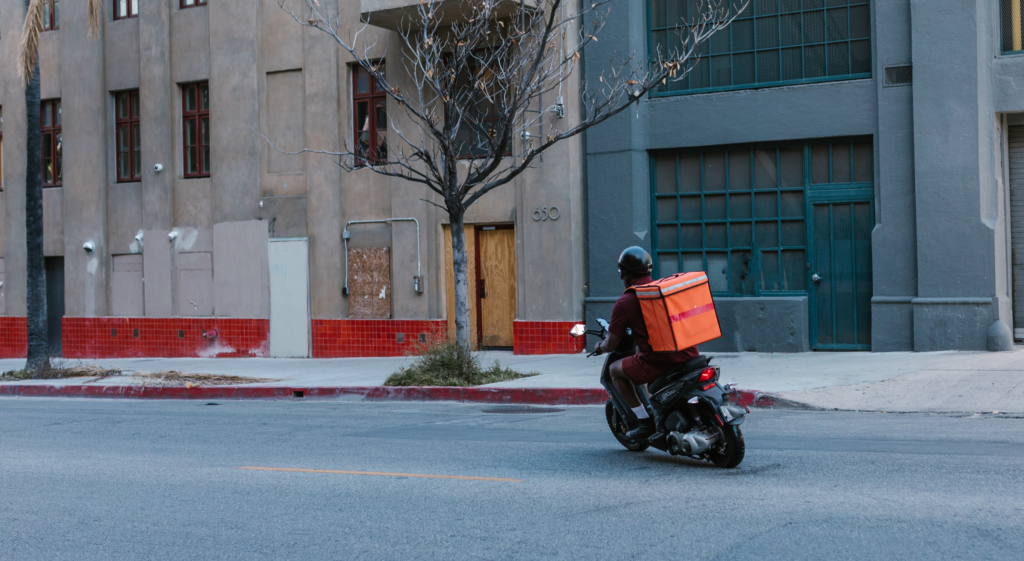
Public Liability Insurance: Safeguarding Against Third-Party Claims
In the fast paced world of courier deliveries, accidents involving members of the public can and do happen with alarming frequency. Public Liability insurance forms a critical third pillar of protection for UK self-employed couriers, covering claims made against you for injury or property damage to third parties. According to data from the Association of British Insurers, courier related public liability claims have increased by 43% in the UK since 2020, reflecting both the growth in delivery services and the heightened risks couriers face daily.
Understanding Public Liability in the UK Courier Context
Public Liability insurance protects you against claims made by members of the public (anyone not employed by you) for incidents that occur in connection with your courier activities.
These claims typically involve:
- Personal injury to members of the public
- Damage to third-party property
- Legal costs defending claims, even unfounded ones
- Compensation payments if you’re found liable
The common misconception among UK couriers is that their vehicle insurance covers these incidents. However, motor insurance typically only covers incidents directly involving your vehicle. For example, if you damage a garden wall while parking, your motor insurance would cover it. But if you trip and drop a package that breaks a customer’s window, or a member of the public trips over a parcel you’ve left, that’s where Public Liability becomes essential.
Common Public Liability Scenarios for UK Couriers
Understanding how Public Liability claims arise can help illustrate why this coverage is so essential. These real-world examples from UK couriers demonstrate the variety of situations where Public Liability insurance proved invaluable:
Scenario 1: Property Damage During Delivery
A Birmingham courier was delivering a heavy package to an office building. While navigating a narrow corridor, he accidentally knocked into an expensive glass display cabinet, causing £3,200 in damage. His Public Liability insurance covered the claim in full.
Scenario 2: Customer Injury
A London food courier left his delivery bag momentarily on a restaurant floor. A customer tripped over it, sustaining a broken wrist. The subsequent claim for medical expenses, lost wages, and compensation totalled £9,400, all covered by his Public Liability policy.
Scenario 3: Third-Party Vehicle Damage
A courier in Edinburgh was carrying multiple parcels when one slipped from his grasp, falling onto a parked car and denting the bonnet. The £1,800 repair bill was covered through his Public Liability insurance.
Scenario 4: Legal Defence Costs
A Manchester courier was wrongfully accused of damaging expensive electronic equipment during a delivery. Although ultimately found not liable, the £7,500 in legal defence costs were fully covered by his Public Liability insurance.
Determining Adequate Coverage Levels
For UK couriers, selecting the appropriate coverage limit for Public Liability insurance requires careful consideration of risk exposure. Industry standards and requirements vary based on several factors:
| Coverage Level | Typical Requirements | Suitable For |
|---|---|---|
| £1 million | Minimum standard for individual couriers | Part-time, low-volume couriers |
| £2 million | Standard for professional couriers | Full-time couriers, suburban/rural areas |
| £5 million | Higher standard for commercial contracts | Urban couriers, high-value locations |
| £10 million | Maximum typically available | Corporate contracts, high-risk environments |
When determining your appropriate coverage level, consider these UK-specific factors:
1. Client Requirements
Many UK businesses and platforms specify minimum Public Liability requirements:
- Amazon Flex: Typically requires £1-2 million
- Corporate clients: Often require £5 million
- Public sector contracts: Frequently require £5-10 million
- Shopping centres and premium locations: May specify higher limits for regular access
2. Working Environment
Your typical delivery locations significantly impact your risk profile:
- Residential deliveries: Lower risk exposure
- Commercial premises: Moderate risk exposure
- High-value locations (hotels, luxury retail): Higher risk exposure
- Public spaces with high foot traffic: Highest risk exposure
3. Delivery Method
How you make deliveries affects your potential liability:
- Vehicle-to-door service: Lower risk of accidents
- Complex delivery paths (stairs, lifts, long corridors): Increased risk
- High volume drop points: Greater exposure to public
- Installation services: Substantially higher risk
Cost Factors for UK Public Liability Insurance
Public Liability premiums for UK couriers typically range from £80 to £500 annually, depending on several factors:
| Factor | Impact on Premium | Common Examples |
|---|---|---|
| Coverage Limit | Direct correlation | £1m (baseline) to £10m (3-4× baseline) |
| Delivery Type | Varies by risk | Parcels (baseline), food (slight increase), furniture (substantial increase) |
| Claims History | Significant impact | No claims (potential discount), recent claims (50-100% increase) |
| Business Size | Scales with activity | Part-time (lower), full-time (higher) |
| Geographic Area | High variation | Rural (lowest), suburban (moderate), urban centres (highest) |
Based on current UK insurance market data, these approximate annual premiums provide a guideline:
| Coverage Level | Part-Time Courier | Full-Time Courier |
|---|---|---|
| £1 million | £80-£150 | £150-£250 |
| £2 million | £120-£200 | £200-£300 |
| £5 million | £180-£300 | £250-£400 |
| £10 million | £250-£400 | £350-£500 |
How Public Liability Works Alongside Other Insurance Types
Understanding how Public Liability integrates with your other courier insurance is essential for comprehensive protection. The UK insurance framework creates these important distinctions:
Public Liability vs. Motor Insurance
While motor insurance covers incidents directly involving your vehicle (hitting another car, injuring a pedestrian while driving), Public Liability covers non-motor incidents that occur during your courier activities (damaging property while carrying parcels, a customer tripping over delivered items).
Public Liability vs. Employers’ Liability
If you employ other drivers or assistants, even casually, UK law requires you to have Employers’ Liability insurance. While Public Liability covers claims from the public, Employers’ Liability covers claims from your employees.
Public Liability vs. Product Liability
Standard Public Liability typically excludes claims arising from the products themselves. For food couriers, this distinction is particularly important – if someone claims food poisoning, that’s typically a Product Liability issue rather than Public Liability.
Public Liability vs. Professional Indemnity
If your courier services include advice or professional judgment (such as specialised medical courier services), Professional Indemnity insurance may be needed alongside Public Liability to cover claims of professional negligence.
Key Policy Features and Exclusions
UK Public Liability policies for couriers typically share several common features and exclusions that you should understand:
Standard Policy Features:
- Legal Costs Coverage
Includes defence costs for claims, even if ultimately unfounded - Immediate Representation
Provides legal representation from the moment a claim is made - Court Attendance Compensation
Compensates for income lost while attending court proceedings - Worldwide Jurisdiction
Coverage applies even if UK visitors make claims after returning home
Common Exclusions:
- Deliberate Acts
Intentional damage or harm is never covered - Contractual Liability
Claims arising from contractual obligations beyond standard legal liability - Motor Claims
Incidents covered by motor insurance policies - Employee Claims
Claims made by employees (requires Employers’ Liability) - Product Liability
Claims about defective products you’ve delivered rather than your delivery service - Cyber and Data Incidents
Data breaches or cyber incidents during delivery activities
Special Considerations for Different Courier Types
Different types of courier work in the UK present unique Public Liability considerations:
Food Delivery Couriers
Food delivery presents specific risks including hot food burns, allergen issues, and spillage damage. Many standard courier Public Liability policies exclude food-specific risks, requiring specialised coverage.
Bicycle and Motorcycle Couriers
Two-wheeled couriers face higher accident risks in tight spaces and when navigating between vehicles or pedestrians. Specialised Public Liability policies address these unique risk profiles.
Home Delivery and Installation
Couriers who enter homes for delivery or installation face increased property damage risks and potential personal injury claims. These activities may require enhanced Public Liability coverage.
Medical and Sensitive Item Couriers
Transporting medical samples, prescription medications, or other regulated items presents unique liability challenges that standard policies may exclude.
Making Successful Public Liability Claims
If an incident occurs that might lead to a Public Liability claim, following these steps will improve your chances of successful resolution:
1. Immediate Documentation
- Photograph the scene and any damage
- Obtain contact details of any witnesses
- Record exact time, date and circumstances
- Note any contributing factors (weather, lighting, obstructions)
2. Prompt Notification
- Inform your insurer immediately, typically within 24 hours
- Use the insurer’s designated claim notification process
- Provide initial documentation and incident report
- Never admit liability at the scene or afterwards
3. Evidence Preservation
- Keep delivery notes and job details
- Preserve CCTV or dashcam footage if available
- Maintain communication records regarding the delivery
- Secure any relevant maintenance records for equipment involved
4. Professional Response
- Allow your insurer to handle all communications with claimants
- Direct all correspondence to your insurance representative
- Cooperate fully with your insurer’s investigation
- Provide any additional information promptly when requested
Public Liability as a Business Credential
Beyond protection, having comprehensive Public Liability insurance serves as an important business credential in the UK courier market. Many clients and platforms explicitly require proof of coverage before contracting services. Professional documentation of your insurance can become a valuable marketing asset when seeking premium courier contracts.
The certificate of insurance should be prominently displayed on your business website, included in proposal documents, and mentioned in your promotional materials. This professional approach signals that you’re a serious, protected business rather than a casual operator, potentially commanding higher rates and better contracts.
In the competitive UK courier market, comprehensive Public Liability protection isn’t just about managing risk, it’s about establishing yourself as a trusted, professional delivery partner who takes responsibility seriously.
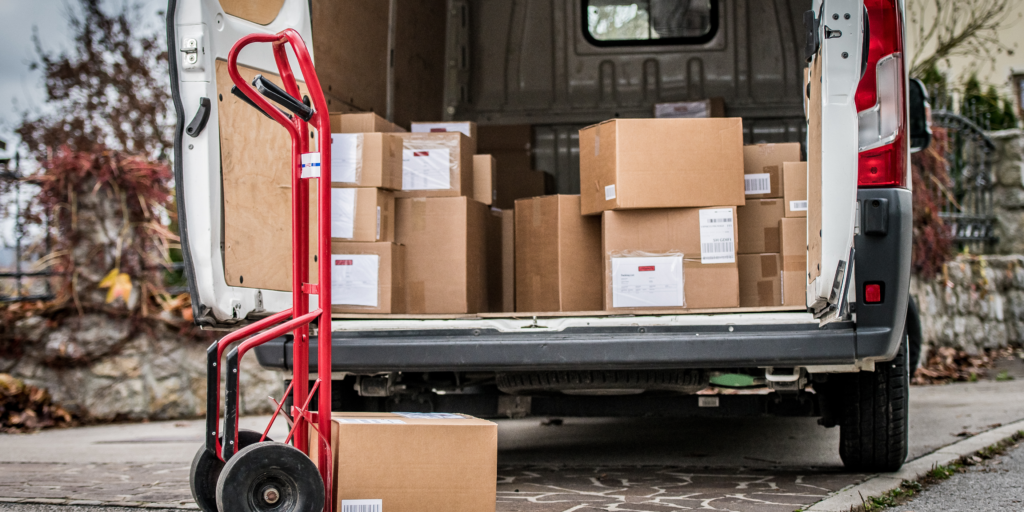
Personal Accident and Income Protection Coverage
While the previous insurance types protect your vehicle, the goods you carry, and your liability to others, there remains a critical exposure that many self-employed UK couriers overlook protection for yourself and your income.
As a self-employed courier, your ability to work is your most valuable asset. According to research by the Association of Independent Professionals and the Self-Employed (IPSE), the average self-employed person in the UK loses approximately £1,500 per month when unable to work, yet only 21% have any form of income protection in place.
The physically demanding nature of courier work makes this protection particularly important. Data from the Health and Safety Executive shows that delivery drivers and couriers experience injury rates approximately 40% higher than average UK workers, with back injuries, falls, and road accidents being the most common causes of work disruption.
Understanding the Gap in State Protection
Many self-employed couriers mistakenly believe they’ll be adequately covered by the UK welfare system if they’re unable to work. However, the reality is far less reassuring:
Statutory Sick Pay (SSP)
As a self-employed courier, you’re not eligible for Statutory Sick Pay, which provides employees with £109.40 per week for up to 28 weeks.
Employment and Support Allowance (ESA)
While you may qualify for ESA if your National Insurance contributions are up to date, the standard rate is just £84.80 per week—significantly below most couriers’ normal earnings.
Universal Credit
Universal Credit may provide some support, but it’s means tested and typically insufficient to cover regular living expenses, with long waiting periods for initial payments.
This protection gap means that without specific personal insurance coverage, an injury or illness could rapidly lead to financial hardship for self-employed couriers.
Personal Accident Insurance vs. Income Protection
UK couriers have two primary options for protecting their income in case of injury or illness, each with distinct characteristics:
| Feature | Personal Accident Insurance | Income Protection Insurance |
|---|---|---|
| What it covers | Specific injuries, typically from accidents only | Inability to work from both illness and injury |
| Payment structure | Lump sum for serious injuries; weekly benefits for temporary disability | Regular monthly payments while unable to work |
| Benefit period | Typically 1-2 years maximum for weekly benefits | Can continue until retirement age if needed |
| Waiting period | Usually 1-7 days | Options from 1 week to 12 months (shorter waiting periods increase premiums) |
| Cost range | £8-£30 per month | £30-£150 per month |
| Tax treatment | Benefits usually tax-free | Benefits usually tax-free for individual policies |
| Medical underwriting | Minimal health questions | Detailed health assessment and potentially exclusions |
Most financial advisers recommend that UK couriers consider a combination of both products for comprehensive protection. Personal Accident for immediate, accident-specific coverage and Income Protection for longer-term security covering both illness and injury.
Calculating Your Coverage Needs
For UK couriers, determining the appropriate level of personal protection requires careful consideration of your specific financial situation:
1. Essential Monthly Expenses
Start by calculating your non-negotiable monthly outgoings:
| Expense Category | Typical Monthly Cost |
|---|---|
| Mortgage/Rent | £600-£1,200 |
| Council Tax | £120-£220 |
| Utilities | £150-£300 |
| Food | £200-£400 |
| Vehicle costs (excluding business) | £100-£250 |
| Insurance premiums | £50-£150 |
| Minimum debt payments | Variable |
2. Business Overhead Expenses
Consider ongoing business costs that would continue even if you’re unable to work:
- Vehicle finance payments
- Business insurance premiums
- Equipment leases
- Storage costs
- Accountancy fees
3. Emergency Fund Assessment
Your existing emergency fund affects your required coverage level:
- No emergency fund: Need higher coverage amount and shorter waiting period
- 1-3 months’ expenses saved: Can consider longer waiting period for lower premiums
- 6+ months’ expenses saved: Can opt for significant waiting period to reduce costs
4. Family Circumstances
Additional factors affecting your coverage needs:
- Dependents increase your coverage requirements
- Partner’s income may reduce necessary coverage
- Caring responsibilities may extend recovery periods
Personal Accident Insurance for Couriers
Personal Accident insurance provides specific benefits for injuries sustained during both work and personal time. For UK couriers, several specialised features are particularly valuable:
Key Coverage Elements:
1. Accidental Death Benefit
Provides a lump sum payment to your beneficiaries, typically between £50,000-£250,000 depending on your policy level.
2. Permanent Disability
Offers lump sum payments for permanent disabilities like loss of limbs, sight, or hearing. Payments usually range from £10,000-£100,000 depending on the specific disability and policy limits.
3. Temporary Total Disability
Provides weekly payments if you’re completely unable to work due to an accident. Typically pays 60-75% of your average weekly income for up to 104 weeks, with maximum weekly benefits usually capped at £500-£750.
4. Temporary Partial Disability
Covers situations where you can work but at reduced capacity or hours. Usually pays 25-40% of your average earnings.
5. Fractured Bones
Pays specific amounts for broken bones, with payments varying by location and severity (£250-£5,000).
6. Hospital Cash
Provides daily payments (typically £50-£200) for each day you’re hospitalized following an accident.
7. Recovery Support
Some policies include rehabilitation services, physiotherapy, and counseling support.
UK-Specific Considerations:
- Look for policies that explicitly cover courier activities without exclusions
- Check for 24/7 coverage rather than work-hours-only protection
- Verify coverage for both on-road and off-road activities (loading, carrying packages)
- Confirm protection extends to all vehicles you might use (car, van, bicycle, motorcycle)
Cost Factors:
For UK couriers, Personal Accident premiums are influenced by:
- Age (premiums increase significantly after age 50)
- Chosen benefit levels and waiting periods
- Delivery method (motorcycle typically highest premiums)
- Pre-existing conditions that may be excluded
- Urban vs. rural operation (urban typically higher)
Income Protection for Couriers
While Personal Accident insurance focuses on injury, Income Protection provides broader coverage including illness, which actually accounts for more than 60% of work absences according to UK health statistics.
Key Features for UK Couriers:
1. Definition of Occupation
UK Income Protection policies use different definitions that significantly impact claims:
- Own Occupation: Pays if you can’t perform your specific job as a courier (best option)
- Suited Occupation: Pays if you can’t do your courier job or similar work you’re qualified for
- Any Occupation: Only pays if you can’t do any work at all (most restrictive)
🔑 Key: Always select “Own Occupation” coverage as a courier, even if premiums are higher.
2. Benefit Period Options
UK providers typically offer these maximum payment periods:
- 1 year (most affordable)
- 2 years
- 5 years
- To retirement age (most comprehensive)
The difference in premium between 5-year and full-term coverage is often modest, making longer protection good value.
3. Deferred Period Selection
The waiting period before benefits begin significantly affects premiums:
| Deferred Period | Premium Reduction vs. 1-Week Waiting Period |
|---|---|
| 1 week | Baseline price |
| 4 weeks | 15-25% reduction |
| 8 weeks | 25-35% reduction |
| 13 weeks | 35-45% reduction |
| 26 weeks | 45-60% reduction |
| 52 weeks | 60-70% reduction |
Choosing a deferred period that aligns with your emergency savings is the most cost-effective approach.
4. Indexation Options
Better policies offer inflation protection through indexation, increasing both your premiums and potential benefits annually in line with either:
- Retail Price Index (RPI)
- Consumer Price Index (CPI)
- Fixed percentage (typically 2-5%)
5. Rehabilitation Support
Quality UK Income Protection includes back-to-work support:
- Partial benefit payments during phased return to work
- Vocational rehabilitation services
- Workplace modification assessment
- Physiotherapy and mental health support
Special Considerations for UK Couriers
1. Platform Workers vs. Independent Couriers
Couriers working for major platforms like Deliveroo, Uber Eats, or Amazon Flex face unique considerations:
- Platform-provided accident coverage is typically minimal (often only while actively delivering)
- Being classified as self-employed means no statutory benefits
- Potential for multiple income sources requires careful coverage structuring
2. Proving Income for Claims
Self-employed couriers must document income to support claims:
- Keep detailed accounting records
- Maintain tax returns and Self Assessment documents
- Consider accountant-certified statements of earnings
- Track income consistently through accounting software
3. Tax Treatment
The tax implications of personal protection policies are significant:
- Personal policies premiums are not tax-deductible business expenses
- Benefits from personal policies are typically tax-free
- Business overhead protection policy premiums may be tax-deductible
- Seek advice from an accountant specialized in self-employed taxation
Real-Life Protection Scenarios for UK Couriers
These real cases illustrate the value of personal protection coverage:
Case Study: Birmingham Delivery Driver
Michael, a parcel courier in Birmingham, suffered a serious back injury while lifting a heavy package. Unable to work for 14 weeks, his Personal Accident insurance provided £500 weekly after a 7-day waiting period, totaling £6,500 in benefits. This covered his essential living expenses while he recovered.
Case Study: Scottish Highlands Courier
Emma, delivering in rural Scotland, developed severe pneumonia during winter and was unable to work for 4 months. Her Income Protection policy with a 4-week deferred period provided £1,800 monthly for 3 months, totaling £5,400. Without this coverage, she would have faced significant financial hardship with only minimal universal credit support.
Case Study: London Food Delivery Rider
Javid, a motorcycle food courier in London, was involved in a traffic accident, breaking his leg and requiring surgery. His comprehensive Personal Accident policy provided:
- £3,000 lump sum for the specific fracture
- £100 daily hospital cash for 8 days (£800)
- £600 weekly income benefit for 16 weeks (£9,600) The total payout of £13,400 protected his finances during recovery.
Cost Effective Strategy for UK Couriers
A strategic approach to personal protection balances coverage and affordability:
1. Tiered Protection Approach
Consider this layered strategy:
- Emergency fund covering 1-3 months’ expenses (self-funded)
- Personal Accident policy with minimal waiting period (1-7 days)
- Income Protection with longer deferred period (13-26 weeks) and longer benefit period
This combination provides immediate protection through savings, quick access to benefits for accidents via Personal Accident coverage, and long-term security through Income Protection.
2. Annual Review Process
As your courier business grows, your protection needs change:
- Review and document your average monthly income quarterly
- Adjust coverage limits annually to match current earnings
- Reassess waiting periods as your emergency fund grows
- Consider additional protection for specific equipment or specialized skills
3. Association Memberships
Several UK courier associations offer group rates on personal protection:
- Courier Exchange members receive discounted coverage
- National Courier and Despatch Association offers group policies
- Independent Workers Union provides access to specialized protection
Personal protection represents the final essential piece of a comprehensive insurance strategy for UK couriers. While vehicle, goods, and liability coverage protect your business assets and obligations to others, personal accident and income protection safeguard your most valuable asset, your ability to earn a living.

Specialised Insurance Options for Different Courier Services
While the core insurance types, Hire and Reward, Goods in Transit, Public Liability, and Personal Accident form the foundation of protection for all UK couriers, different delivery specialisations present unique risks and insurance requirements.
The UK courier market has diversified significantly in recent years, with many self-employed couriers focusing on specific niches that demand tailored insurance solutions.
Food Delivery Courier Insurance Requirements
The food delivery sector has experienced explosive growth in the UK, with platforms like Deliveroo, Just Eat, and Uber Eats creating opportunities for thousands of self-employed couriers. However, this specialisation comes with distinct insurance requirements:
Core Insurance Considerations for Food Couriers:
1. Modified Hire and Reward Coverage
Food delivery presents unique vehicle insurance challenges:
- Fast-Paced Delivery Windows: The time-sensitive nature of food delivery creates pressure that can increase accident risk
- Higher Frequency Stops: Multiple deliveries per hour increase exposure to collision risks
- Anti-Social Hours: Evening and weekend work during peak ordering times presents additional risks
Many mainstream insurers exclude food delivery from standard courier policies, making specialist providers essential. Leading options include:
- Zego: Pioneered pay-per-hour and flexible coverage specifically for food delivery riders
- MCE Insurance: Offers dedicated food courier policies for motorcycles and scooters
- Deliveroo Partner Insurance: Provided through Zego with specific terms for platform riders
2. Hot Food Liability Considerations
Food delivery introduces specific liability concerns:
- Burn Injuries: Hot food spills can cause injuries to customers or third parties
- Allergic Reactions: Cross-contamination during transport can trigger allergic responses
- Food-Borne Illness: Improper handling or temperature control may contribute to illness claims
Standard Public Liability policies often exclude food-specific claims, requiring either endorsements or specialist coverage. Look for policies that explicitly cover “food courier activities” rather than general courier liability.
3. Temperature-Controlled Goods in Transit
Food delivery requires specialised Goods in Transit considerations:
- Hot Food Integrity: Protection for maintaining food temperature and quality
- Cold Chain Compliance: For ice cream, chilled items, and frozen products
- Contamination Coverage: For incidents affecting food safety during transport
Most standard Goods in Transit policies exclude perishable items, making specialised coverage essential.
4. Equipment Protection
Food delivery requires specific equipment that needs protection:
- Thermal Bags and Containers: Often expensive and essential to operation
- Mobile Payment Devices: For processing transactions at delivery
- Platform-Provided Equipment: Which you may be contractually responsible for
Specialist equipment cover as an extension to existing policies typically costs £30-£80 annually for up to £1,000 of equipment.
Cost Considerations:
Food delivery insurance in the UK typically commands a 15-30% premium over standard courier insurance due to the increased risks, with annual costs typically ranging:
| Coverage Type | Cost Range for Food Delivery |
|---|---|
| Hire and Reward | £1,800-£4,000 annually |
| Public Liability (with food extension) | £200-£350 annually |
| Specialised Goods in Transit | £150-£300 annually |
| Equipment Cover | £30-£80 annually |
Medical Courier Insurance Requirements
Medical couriers transport samples, medications, equipment, and other healthcare related items, creating unique risk profiles and regulatory requirements:
Core Insurance Considerations for Medical Couriers:
1. Enhanced Goods in Transit Coverage
Medical deliveries require specialised Goods in Transit protection:
- Higher Value Items: Medical equipment and certain pharmaceuticals can be extremely valuable
- Temperature Controlled Transport: Many items require strict temperature maintenance
- Chain of Custody Documentation: Legal and regulatory requirements for handling
- Controlled Substance Considerations: Special requirements for certain medications
UK insurers offering specialised medical courier Goods in Transit include:
- Hiscox Courier Insurance: Offers medical specialisation options
- Markel Direct: Provides pharmaceutical courier coverage
- Ascend Broking: Specialises in healthcare logistics insurance
Coverage limits typically need to be 2-3 times higher than standard courier Goods in Transit policies, with £25,000-£50,000 limits being common.
2. Regulatory Compliance Coverage
Medical couriers face unique regulatory requirements:
- MHRA (Medicines and Healthcare products Regulatory Agency) Compliance
- Clinical Trial Material Handling
- Data Protection for Patient Information
- Hazardous Material Transport Regulations
Specialist policies include cover for regulatory defence costs and compliance consultation. Costs typically range from £250-£500 annually for this regulatory extension.
3. Enhanced Liability Coverage
Medical couriers face elevated liability risks:
- Medical Consequences of Delayed Delivery
- Patient Impact from Damaged Items
- Confidentiality Breaches
- Cross-Contamination Incidents
Standard Public Liability policies typically exclude these healthcare-specific risks. Medical courier liability extensions cost approximately 30-50% more than standard courier liability coverage.
4. Specialist Vehicle Requirements
Vehicles used for medical deliveries may require:
- Temperature Control Certification
- Secure Compartment Documentation
- Specialised Cleaning and Sanitisation Protocols
- Specific Loading Equipment Insurance
Vehicle modifications needed for medical transport should be explicitly declared and covered in your insurance policy.
Cost Considerations:
Medical courier insurance in the UK typically commands a significant premium over standard courier coverage:
| Coverage Type | Cost Range for Medical Couriers |
|---|---|
| Hire and Reward | £2,200-£4,500 annually |
| Enhanced Goods in Transit | £400-£800 annually |
| Specialised Public Liability | £300-£600 annually |
| Regulatory Compliance Cover | £250-£500 annually |
High-Value Item Courier Insurance
Couriers specialising in valuable items like electronics, jewellery, artwork, or luxury goods require enhanced protection due to higher theft risk and increased liability:
Core Insurance Considerations for High-Value Couriers:
1. Expanded Goods in Transit Limits
Standard GIT policies typically cap at £10,000-£15,000, insufficient for high-value specialisation:
- Per-Item Limits: Need significant increases from standard £1,000-£2,500 caps
- Aggregate Coverage: Typically requires £50,000-£100,000 minimum
- Pairs and Sets Coverage: Important for collections and multi-part items
- Valuation Methodology: Pre-agreed values vs. market value considerations
UK insurers with strong high-value courier offerings include:
- NIG Commercial: Offers specific high-value courier GIT options
- Allianz Commercial: Provides customisable limits for valuable item transport
- Ascend Specialty Risks: Focuses on jewellery and valuable couriers
2. Enhanced Security Requirements
High-value courier insurance policies typically mandate specific security measures:
- Vehicle Security: Upgraded alarms, immobilisers, and tracking systems
- Secure Loading Protocols: Specific procedures for collection and delivery
- Two-Person Operations: Some policies require two people for high-value deliveries
- Route Planning Requirements: Pre-approved routes and risk assessment
Compliance with these security requirements is typically a condition of coverage rather than an optional recommendation.
3. Specialist Liability Considerations
High-value deliveries create elevated liability concerns:
- Higher Financial Exposure: Claims can reach six or seven figures
- Client Contractual Requirements: Often mandate higher minimum coverage
- Consequential Loss Exposure: Business impact beyond the item’s direct value
- Brand Reputation Considerations: Luxury brands may require additional protections
Public Liability limits for high-value couriers typically start at £5 million rather than the standard £1-2 million.
Cost Considerations:
High-value courier insurance commands significant premiums, reflecting the increased risk:
| Coverage Type | Cost Range for High-Value Couriers |
|---|---|
| Hire and Reward | £2,500-£5,000 annually |
| Specialised Goods in Transit | £800-£2,500 annually |
| Enhanced Public Liability | £400-£800 annually |
| Security System Requirements | £500-£1,500 one-time costs |
International Delivery Insurance Requirements
For UK couriers who handle international deliveries, additional insurance considerations come into play:
Core Insurance Considerations for International Couriers:
1. International Goods in Transit
Standard UK GIT policies typically exclude international transit, requiring specific coverage:
- Territorial Limits: Policies may cover EU only, worldwide excluding USA/Canada, or truly worldwide
- Customs Value Coverage: Protection for duties, taxes, and fees
- International Documentation: Coverage for errors and omissions in paperwork
- Different Legal Jurisdictions: Protection under various legal systems
Since Brexit, international courier insurance has become increasingly complex, with new distinctions between EU and non-EU coverage.
2. International Liability Considerations
Liability exposure increases significantly when operating across borders:
- Different Legal Standards: Varying liability definitions by country
- Currency Fluctuations: Affecting claim values and settlements
- Jurisdictional Defence Costs: Significantly higher for international claims
- Local Regulatory Requirements: Which may impose additional liability
International liability extensions typically increase premiums by 50-100% over domestic-only coverage.
3. Carnets and Financial Guarantee Insurance
International couriers often need financial guarantees for:
- ATA Carnets: Temporary export/import documentation
- Transit Guarantees: Financial security for goods in cross-border transit
- Customs Bonds: Financial guarantees for duties and taxes
- Financial Failure Protection: In case of shipping partner insolvency
These specialised financial products typically cost £200-£500 per carnet or £500-£1,500 annually for comprehensive coverage.
Cost Considerations:
International courier insurance premiums reflect the complex risk landscape:
| Coverage Type | Cost Range for International Couriers |
|---|---|
| International Hire and Reward | £2,800-£6,000 annually |
| International Goods in Transit | £600-£1,500 annually |
| International Public Liability | £400-£900 annually |
| Carnet and Financial Guarantees | £500-£1,500 annually |
Bicycle and Motorcycle Courier Insurance
Two-wheeled couriers face unique risks and insurance requirements compared to van or car couriers:
Core Insurance Considerations for Two-Wheeled Couriers:
1. Specialised Vehicle Coverage
Two-wheeled courier insurance differs significantly from car/van coverage:
For Bicycles:
- Bicycle Value Coverage: Protection for high-value delivery bikes
- Electric Bicycle Considerations: Battery, motor, and electrical component coverage
- Accessory Protection: For panniers, GPS units, and courier equipment
- Off-Bike Coverage: Protection while temporarily dismounted during delivery
Leading UK bicycle courier insurance providers include:
- Bikmo: Offers specific courier bicycle insurance
- Laka: Provides flexible coverage for delivery cyclists
- Yellow Jersey: Specialises in high-value bicycle courier insurance
For Motorcycles/Scooters:
- Higher Risk Category: Motorcycle couriers face the highest insurance premiums due to accident rates
- Specific Vehicle Modifications: For delivery boxes, GPS mounts, and other courier equipment
- Specialised Gear Coverage: For protective clothing and safety equipment
- Higher Theft Risk Profile: Requiring enhanced security measures
Leading UK motorcycle courier insurers include:
- MCE Insurance: Specialises in courier motorcycle coverage
- Lexham Insurance: Offers dedicated delivery rider policies
- Principal Insurance: Provides competitive rates for scooter couriers
2. Personal Accident Considerations
Two-wheeled couriers face significantly higher injury risks:
- Increased Accident Probability: UK statistics show motorcycle couriers are 5x more likely to be injured than van couriers
- More Severe Injury Profile: Injuries tend to be more serious when they occur
- Weather-Related Risks: Greater vulnerability to adverse conditions
- Road Surface Hazards: Higher risk from potholes, gravel, and road debris
Personal Accident premiums for two-wheeled couriers are typically 40-100% higher than for van/car couriers, reflecting this increased risk.
3. Limited Goods Capacity Considerations
The limited carrying capacity creates unique GIT considerations:
- Lower Limits Typically Required: Due to physical carrying constraints
- Specialised Coverage: For weatherproof bags and containers
- Fragile Item Considerations: Due to increased vibration and impact risk
- Temperature Fluctuation Exposure: Particularly for food delivery
Cost Considerations:
Insurance costs vary significantly between bicycle and motorcycle couriers:
Bicycle Courier Insurance:
| Coverage Type | Cost Range for Bicycle Couriers |
|---|---|
| Bicycle Insurance | £200-£500 annually |
| Public Liability | £80-£200 annually |
| Goods in Transit | £100-£250 annually |
| Personal Accident | £150-£400 annually |
Motorcycle Courier Insurance:
| Coverage Type | Cost Range for Motorcycle Couriers |
|---|---|
| Hire and Reward | £1,000-£3,500 annually |
| Public Liability | £150-£300 annually |
| Goods in Transit | £150-£300 annually |
| Personal Accident | £200-£500 annually |
Emerging Specialist Insurance Markets
The evolving UK courier landscape continues to create new specialised insurance needs:
1. Same-Day Critical Delivery
Couriers specialising in urgent, time-critical deliveries face unique considerations:
- Consequential Loss Coverage: For financial impact of delayed delivery
- Time Guarantee Insurance: Specific protection for delivery timeline commitments
- Out-of-Hours Operation: Coverage for extended and unusual working hours
- Priority Route Risk Assessment: Special consideration for expedited routing
These specialised policies typically command a 25-50% premium over standard courier insurance.
2. Green Courier Services
Eco-friendly delivery services using electric vehicles, cargo bikes, or alternative transport have emerging insurance options:
- Electric Vehicle Specialist Coverage: Addressing battery, charging, and range risks
- Carbon-Offset Certification Protection: For couriers with environmental certifications
- Sustainable Business Practices Coverage: Protecting green business credentials
- Alternative Vehicle Specialist Insurance: For unusual delivery vehicles like cargo trikes
Several UK insurers now offer “green courier discounts” of 5-15% for environmentally friendly delivery operations.
3. Last-Mile Logistics Specialists
Couriers focusing exclusively on final-mile delivery have distinct risk profiles:
- Urban Centre Concentration: Operating primarily in congested areas
- Multiple Short Stops: Rather than longer transit periods
- Residential Delivery Focus: With specific private property access requirements
- Integrated Technology Risks: For routing and delivery confirmation systems
Specialised last-mile policies are emerging with premiums approximately 10-20% lower than full-service courier coverage, reflecting the reduced distance risk.
Regardless of your courier specialisation, understanding the unique risks of your delivery niche is essential for securing appropriate, comprehensive insurance protection. Working with insurance brokers who understand your specific courier segment can help identify the most appropriate and cost-effective coverage for your unique business model.
Navigating the world of courier insurance doesn’t have to be overwhelming! By securing the essential coverage types discussed, commercial hire and reward, goods in transit, public liability, and personal accident protection, you’ll create a comprehensive safety net for your self-employed courier business.
💡 Important: Remember, the right insurance isn’t just about meeting legal requirements; it’s about protecting your livelihood, your future, and your peace of mind. Take time to compare quotes from multiple providers, consider taking out multiple polices with the same specialised broker for savings, and review your cover annually with your insurance account manager as your business grows.
The small monthly investment in proper insurance coverage can save you tens of thousands in potential losses down the road. Ready to protect your courier business? Start by requesting quotes from courier-specialised insurance providers today!
This guide is intended for informational purposes only and does not constitute legal or insurance advice. Always consult with your insurance provider or legal professional for specific guidance regarding your policy.
Need to Speak?
If you can’t find the answer to your question and need to discuss with an agent who can help answer and possibly look to place you with the relevant insurer to suit your business needs, click below for an immediate call back






